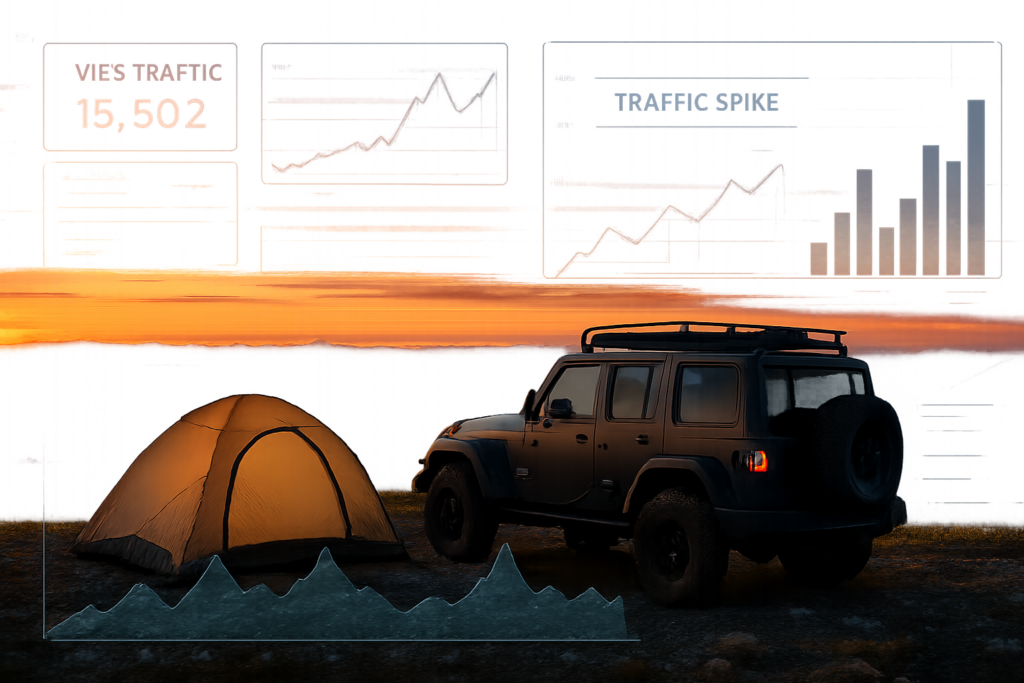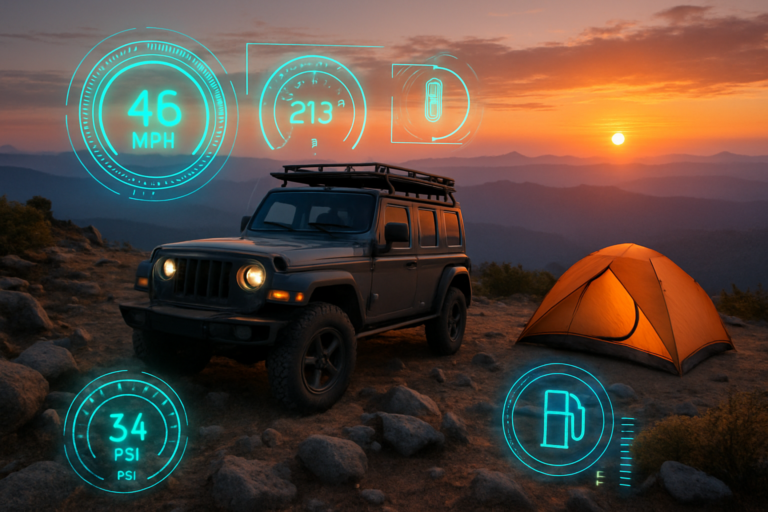Media companies and outdoor brands face strikingly similar digital challenges: explosive traffic during critical moments, complex content management across multiple properties, and the need for flawless performance when revenue is on the line. The key difference? Media companies have already solved these problems at enterprise scale.
Understanding these solutions reveals a roadmap for outdoor brands ready to scale beyond traditional e-commerce limitations.
Traffic Surge Reality: The Numbers Don’t Lie
Breaking News vs. Product Drops
When FiveThirtyEight handled 1.3 billion page views during US Election Week 2020, including 132,000 requests per second at peak while maintaining 144-millisecond response times, they demonstrated the infrastructure requirements that outdoor brands face during their own critical moments.
The traffic patterns reveal striking similarities:
| Scenario | Media Example | Outdoor Brand Equivalent | Infrastructure Challenge |
|---|---|---|---|
| Breaking News | FiveThirtyEight: 132,000 req/sec during elections | REI: 716,000 Black Friday visitors (36% YoY increase) | Handling sudden 10x traffic spikes |
| Viral Content | TIME: 100,000+ req/sec for major announcements | Arc’teryx: 3.7M monthly visits, 13.45% month-over-month growth | Sustained high-volume performance |
| Global Audience | Reuters: Worldwide news delivery | International outdoor brands serving 30+ countries | Multi-region content delivery |
| Mobile Priority | BBC: Mobile-first news consumption | REI: 52% mobile traffic during peak periods | Optimized mobile experiences |
REI’s #OptOutside campaign demonstrates the infrastructure reality outdoor brands must navigate. During their 2016 Black Friday campaign, REI managed 716,000 visitors on Black Friday and 1.019 million visitors on Cyber Monday—sustained multi-day traffic surges requiring enterprise-grade infrastructure.
Performance Benchmarks: What Publishers Know
Response Time Standards Across Industries
Media companies have established performance benchmarks that translate directly to outdoor commerce success. TIME.com successfully handled over 100,000 requests per second during major announcements. Leading media sites consistently achieve sub-200 millisecond response times through infrastructure optimization—improvements that dramatically impact user experience and search rankings.
For outdoor brands, these metrics matter because:
- Every 100ms delay can reduce conversions by up to 7%
- Mobile performance becomes critical when 52% of traffic occurs on mobile devices
- Global consistency ensures international customers receive identical experiences
- Peak handling prevents revenue loss during seasonal surges
The Architecture Challenge: Beyond Basic E-commerce
Complex Integration Requirements
Outdoor brands require sophisticated technical capabilities that traditional e-commerce platforms struggle to provide:
Fitment and Compatibility Systems: Modern outdoor brands need “Will-this-fit-my-rig?” functionality requiring structured product data, real-time inventory integration, and complex compatibility matrices.
Dealer Network Management: Many outdoor brands operate dual-channel systems requiring public consumer sites and private dealer portals with different pricing, access controls, and territory management.
International Scaling: Success across multiple countries demands multi-region performance, localized content delivery, and international compliance standards.
Content-Heavy Experiences: With outdoor customers expecting detailed product information, video content, and user-generated galleries, brands must deliver complex, media-rich experiences without performance degradation.

Performance Optimization Strategies
Infrastructure Planning for Seasonal Success
1. Traffic Pattern Analysis
Outdoor brands experience predictable seasonal surges. Memorial Day, Black Friday, and spring product launches create traffic spikes similar to media companies during breaking news events. Understanding these patterns enables proactive infrastructure planning rather than reactive crisis management.
2. Global Performance Strategy
With international markets representing significant growth opportunities, outdoor brands need content delivery networks optimized for global performance. This includes edge caching, regional server deployment, and localized asset optimization to ensure consistent experiences regardless of geographic location.
3. Mobile-First Architecture
Given that outdoor enthusiasts frequently access content from remote locations with limited connectivity, mobile optimization becomes critical. This requires progressive web app capabilities, offline functionality, and optimized image delivery for varying connection speeds.
4. Security and Compliance Standards
Enterprise outdoor brands need SOC-2 compliance for dealer networks, international data protection compliance, and security standards that protect both customer and dealer information across complex multi-channel operations.
Case Study Analysis: Media Principles Applied
Publisher-Grade Infrastructure for Adventure Commerce
The most successful outdoor brands have adopted infrastructure principles pioneered by media companies:
CNN manages breaking news traffic spikes → Outdoor brands handle seasonal product launches using similar auto-scaling architecture
Reuters coordinates global content operations → Adventure companies manage international markets with comparable multi-region deployment
BBC maintains multiple brand properties → Outdoor portfolios oversee diverse product lines through unified content management systems
These parallels aren’t coincidental—they reflect fundamental infrastructure requirements for content-rich, high-traffic digital experiences that must perform flawlessly when stakeholder attention peaks.
The Business Impact of Performance
Quantifiable Results from Infrastructure Investment
Performance improvements deliver measurable business impact across multiple dimensions:
Revenue Impact: Conversion rate improvements directly correlate with faster load times, with industry data showing 7% conversion drops for every 100ms of additional load time.
Search Visibility: Search engine rankings benefit significantly from improved Core Web Vitals, affecting organic traffic and discovery.
Customer Experience: Reliable, fast experiences increase customer satisfaction scores and reduce support ticket volume related to site performance issues.
Operational Efficiency: Streamlined content workflows and automated scaling reduce operational overhead while improving team productivity.
Brand Perception: Consistent high-performance experiences reinforce premium brand positioning, particularly important for outdoor brands competing on quality and reliability.
Implementation Considerations
Planning Your Infrastructure Evolution
Assessment Phase: Benchmark current performance against industry standards, document traffic patterns during peak seasons, and identify critical integration requirements for existing systems.
Architecture Planning: Design infrastructure for predictable seasonal surges, plan global deployment strategy for international expansion, and ensure mobile-first performance optimization.
Integration Strategy: Map existing systems including PIM, ERP, and dealer portals, plan for complex product data requirements, and design for future growth and flexibility.
Testing and Optimization: Implement comprehensive monitoring across all critical metrics, conduct regular load testing before major campaigns, and maintain ongoing performance optimization protocols.
Future-Proofing Your Digital Foundation
Preparing for Industry Evolution
The outdoor industry’s evolution toward content-first commerce requires infrastructure that matches these ambitions. Brands that adopt publisher-grade platforms position themselves for sustainable growth in an increasingly competitive market where digital experience differentiates winners from followers.
Key considerations for future success include:
- AI and personalization readiness through structured data models
- Omnichannel integration supporting seamless customer journeys
- Scalability for international expansion without platform migrations
- Performance standards that exceed customer expectations consistently
The most successful outdoor brands recognize that infrastructure isn’t just a technical requirement—it’s a competitive advantage that enables everything from superior customer experiences to operational efficiency gains that compound over time.
Ready to evaluate your current platform performance? Take our Adventure-Commerce Readiness Quiz to benchmark your infrastructure against publisher-grade standards and receive a customized optimization roadmap. For detailed technical guidance, schedule a consultation with our enterprise WordPress experts at Ndevr—certified WordPress VIP partners specializing in outdoor industry implementations.





